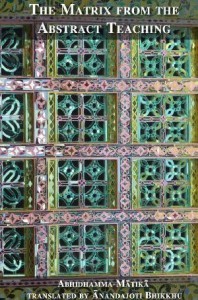
The Matrix of the Abstract Teaching is a direct translation from the beginning of the Abhidhamma or “abstract/higher teaching” in the Pali Canon. It is a table or grid from which other doctrines are classified in the seven Abhidhamma books or sections, it is therefore used as a reference point for the other doctrines, suitable for students.
The matrix is divided into three parts, the triplets matrix, the pairs matrix and the pairs matrix from the discourses. These instructions comes with no further explanations, such as:
Triplet Matrix – 15:
Things that are wrongful and have a fixed destiny
Things that are righteous and have a fixed destiny
Things that do not have a fixed destiny
Download The Matrix of the Abstract Teaching – the third book in our series of meditation instructions derived from the Pali Canon – here:
 The Matrix of the Abstract Teaching
The Matrix of the Abstract Teaching
What is the Abhidhamma?
The Abhidhamma is a philosophical and psychological analysis of human experience found within the Buddhist tradition. It is one of the three main sections of the Tripitaka, the ancient Buddhist scriptures. The Tripitaka consists of the Vinaya Pitaka (rules for monastic discipline), the Sutta Pitaka (discourses of the Buddha), and the Abhidhamma Pitaka (higher teachings).
The Abhidhamma is considered the most analytical and detailed of the three Pitakas. It aims to provide a systematic and comprehensive understanding of the nature of reality and the workings of the mind. The word “Abhidhamma” can be translated as “higher teaching” or “special doctrine.”
Fundamental components of human experience
The Abhidhamma analyzes the fundamental components of human experience, breaking them down into their ultimate elements. It explores various aspects of consciousness, mental factors, and material phenomena to provide a detailed understanding of the nature of existence. It presents a highly structured and technical system of classification, categorization, and analysis.
The Abhidhamma covers a wide range of topics, including psychology, ethics, cosmology, and metaphysics. It aims to provide practitioners with a deep understanding of the nature of reality and the causes of suffering. By understanding the workings of the mind and the nature of phenomena, one can cultivate insight and wisdom, leading to liberation from suffering.
A Complex and specialized field of study within Buddhism
The Abhidhamma is primarily associated with the Theravada school of Buddhism, which is practiced in Southeast Asian countries such as Sri Lanka, Thailand, Myanmar (Burma), Cambodia, and Laos. However, elements of Abhidhamma can also be found in other Buddhist traditions to varying degrees.
It is important to note that the Abhidhamma is a complex and specialized field of study within Buddhism. It requires careful study and guidance from qualified teachers to fully grasp its intricacies and practical applications.

Well I enjoy your book
Thank you